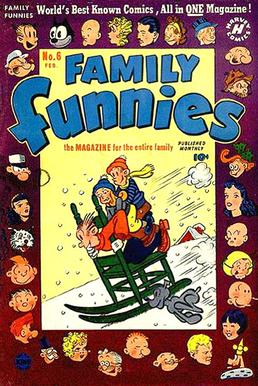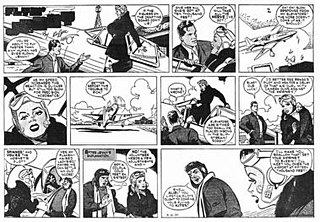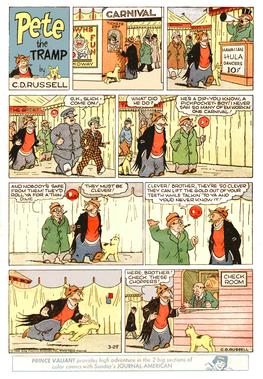Tailspin Tommy was an aviation-adventure comic strip about a youthful pilot, "Tailspin" Tommy Tomkins. Originally illustrated by Hal Forrest and initially distributed by John Neville Wheeler's Bell Syndicate and then by United Feature Syndicate, the strip had a 14-year run from May 21, 1928 to March 15, 1942.

Scorchy Smith is an American adventure comic strip created by artist John Terry that ran from March 17, 1930 to December 30, 1961.
The Batman comic strip began on October 25, 1943, a few years after the creation of the comic book Batman. At first titled Batman and Robin, and briefly lengthened to Batman with Robin the Boy Wonder as a tie-in with the 1966 Batman television series, a later incarnation was ultimately shortened to Batman. The comic strip had three major and two minor runs in American newspapers.

The Sunday comics or Sunday strip is the comic strip section carried in some Western newspapers. Compared to weekday comics, Sunday comics tend to be full pages and are in color. Many newspaper readers called this section the Sunday funnies, the funny papers or simply the funnies.

Jungle Jim is the fictional hero of a series of jungle adventures in various media. The series began on January 7, 1934, as an American newspaper comic strip chronicling the adventures of Asia-based hunter Jim Bradley, who was nicknamed Jungle Jim. The character also trekked through radio, film, comic book and television adaptations. Notable was a series of films and television episodes in which Johnny Weissmuller portrayed the safari-suit wearing character, after hanging up his Tarzan loincloth. The strip concluded on August 8, 1954.

Mickey Finn was an American comic strip created by cartoonist Lank Leonard, which was syndicated to newspapers from April 6, 1936 to September 10, 1977. The successful lighthearted strip struck a balance between comedy and drama. It was adapted to a 400-page Little Big Book and was reprinted in several comic book series throughout the 1930s and 1940s.

Reg'lar Fellers is a long-running newspaper comic strip adapted into a feature film, a radio series on the NBC Red Network, and two animated cartoons. Created by Gene Byrnes (1889–1974), the comic strip offered a humorous look at a gang of suburban children. Syndicated from 1917 to January 18, 1949, Byrnes' strip was collected into several books. Branding also extended to such items as baseball bats and breakfast cereal.

The Adventures of Smilin' Jack is an aviation comic strip that first appeared October 1, 1933, in the Chicago Tribune and ended April 1, 1973.
King of the Royal Mounted is an American comics series which debuted February 17, 1935 by Stephen Slesinger, based on popular Western writer Zane Grey's byline and marketed as Zane Grey's King of the Royal Mounted. The series' protagonist is Dave King, a Canadian Mountie who always gets his man and who, over the course of the series, is promoted from Corporal to Sergeant. King has appeared in newspaper strips, comics, Big Little Books, and other ancillary items.

Toots and Casper is a family comic strip by Jimmy Murphy, distributed to newspapers for 38 years by King Features Syndicate, from December 17, 1918 to December 30, 1956. The strip spawned many merchandising tie-ins, including books, dolls, paper dolls, pins, bisque nodders and comic books.

The Bungle Family is an American gag-a-day comic strip, created by Harry J. Tuthill, that first appeared in 1918. Originally titled Home, Sweet Home, it first appeared as part of a series of rotating strips in the New York Evening Mail. The strip ran until June 2, 1945.
Richard William Calkins, who often signed his work Lt. Dick Calkins, was an American comic strip artist who is best known for being the first artist to draw the Buck Rogers comic strip. He also wrote for the Buck Rogers radio program.

Flyin' Jenny was an aviation adventure comic strip created by illustrator Russell Keaton and distributed to newspapers by Bell Syndicate from October 2, 1939, to July 20, 1946.

The McNaught Syndicate was an American newspaper syndicate founded in 1922. It was established by Virgil Venice McNitt and Charles V. McAdam. Its best known contents were the columns by Will Rogers and O. O. McIntyre, the Dear Abby letters section and comic strips, including Joe Palooka and Heathcliff. It folded in September 1989.

Pete the Tramp is an American comic strip by Clarence D. Russell (1895–1963) which was distributed by King Features Syndicate for more than three decades, from January 10, 1932 to December 22, 1963. Howard Eugene Wilson, in the Harvard Educational Review, described the strip's title character as "a hobo with a gentleman's instincts."

Richard Sidney Yager was an American cartoonist most famous for his work on the Buck Rogers comic strip during its heyday in the mid-20th century.

Zack Terrell Mosley was an American comic strip artist best known for the aviation adventures in his long-running The Adventures of Smilin' Jack which ran in more than 300 newspapers from 1933 to 1973.

Archie is a long-running American comic strip based on the line of the popular Archie Comics featuring the character Archie Andrews. Launched by McClure Newspaper Syndicate on February 4, 1946, it features the misadventures of Archie Andrews and his pals. Archie is currently distributed by the Creators Syndicate.

Buck Rogers is a science fiction adventure hero and feature comic strip created by Philip Francis Nowlan first appearing in daily U.S. newspapers on January 7, 1929, and subsequently appearing in Sunday newspapers, international newspapers, books and multiple media with adaptations including radio in 1932, a serial film, a television series, and other formats.
The National Newspaper Syndicate, originally known as the John F. Dille Co., was a syndication service that operated from 1917 to c. 1984. It was founded by Chicago businessman John F. Dille and specialized in comic strips and gag cartoons. It also carried advice columns, such as Paul Popenoe's "Modern Marriage". It is most well known for syndicating Buck Rogers, considered by many to be the first adventure comic strip.

















